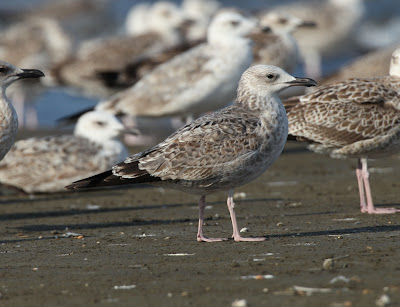 I spent 11-24 September of this year in Azerbaijan. The main aim of the trip was to study Caspian Gull in the core of its range, away from the hybrid zone(s). I arrived hoping to see only Caspian, but it soon became clear (based on adults) that other taxa were present. This of course muddied the water as far as the identification of the 1cy birds was concerned. With this in mind, here is a selection of the 1 cy birds present at Sijazan. To simplify matters, all are from the same 2 day period - in this context, note the different extent of moult and wear on these individuals.
I spent 11-24 September of this year in Azerbaijan. The main aim of the trip was to study Caspian Gull in the core of its range, away from the hybrid zone(s). I arrived hoping to see only Caspian, but it soon became clear (based on adults) that other taxa were present. This of course muddied the water as far as the identification of the 1cy birds was concerned. With this in mind, here is a selection of the 1 cy birds present at Sijazan. To simplify matters, all are from the same 2 day period - in this context, note the different extent of moult and wear on these individuals.I think many/most are Caspian but some I'm not sure about. Actually I have not had time to really work through all the birds, so I thought I would post them up here and share them. At the end are a few birds that are clearly not Caspian.
I hope you find the variability as bewildering as I do. In a post to follow I will put up images showing underwings.






















































































5 comments:
Bird travel cage is ideal for taking your bird to travel with you. Not only these bird travel carriers are great for taking your bird with you on a trip, you can also use it to carry it with you to the vet, to grooming or any other places. You will not regret it once finding the right bird travel cage for your bird. Now you too can travel happily together.
There you go Chris. If you only had brought a Bird travel cage you could have taken the gulls back home with you...
Jan
Some variety in amongst that lot! A bit more than we got at Seaton Common.
hi chris,
once again i'm highly impressed about this series of quality photos and to me this visual approach is at least as valuable as doing DNA research or CR-reading, well, especially where there ain't any CR ;)
and i really appreciate your personal effort in taking good comparison photos of gulls over the world (i read about your difficulties at the caspian sea shore in taking these pics). so, well, this is the first time we see 1cys in september close to their breeding grounds/midway to their wintering grounds.
i see some tendencies (to use with care of course):
1. the huge variability in eastern cachs and barabensis - as expected.
2. generally they seem to be faster in postjuvenile moult than ponticus, similar to southern/eastern/atlantic michahellis. maybe this is an adaptation to the strong continental climate (winds, dust) causing wear and the need for early replacement. but as seen there is a huge variation in it too.
3. tendency for strong marked ind. (wholly black scaps centers, bold 2nd gen. covert marks), though the opposite is possible. it is said that barabensis tends to show such strong markings but i feel that eastern caspian does to the same extent! black sea cachs also look slightly different (tendentially stronger marked) than central european birds as you may have observed yourself.
4. since both fuscus and heuglini vary structurally it's probably impossible to tell juvs apart. you have seen 1 ad fuscus and among the last 3 birds in your set might be another 1-2 but on probability most fresh/cold dark coloured/totally juvenile 1cy in your set are heuglini. baltic gulls have a small declining population and tend to winter further west, heuglini are spread all over(?) the russian tundra and even south of that, and the main migration route of western heuglini should concentrate in southern caspian sea, very few pass through the black sea acc. to present knoledge (sorry, not that i tell you something new...).
great job!
well, and: please let them gulls where they are ;)
Some of the clearest photos I've seen of 1st cycle Caspians.
Thanks, Chris.
Amar Ayyash
Frankfort IL, USA
Post a Comment